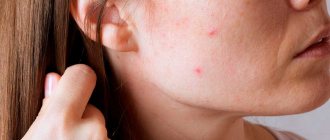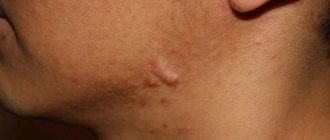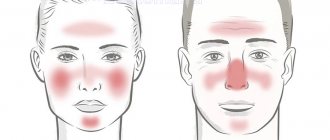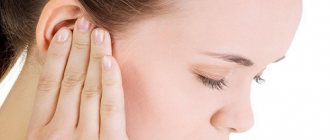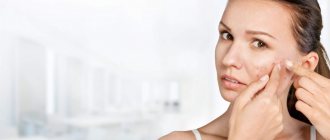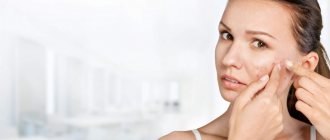Published: 11/01/2021 15:25:00 Updated: 11/01/2021
Acne is a chronic inflammatory skin disease caused by excessive sebum production and blockage of the sebaceous gland ducts. As a result of the accumulation of secretions, blackheads characteristic of acne appear.
In adolescents, acne is considered the most common skin disease, and in general it affects more than 65% of the population. Most often, the disease is observed on the skin of the face, representing not only a medical, but also a cosmetic problem.
Acne is not an independent disease, but a symptom of one or more disorders in the body. Without timely and appropriate treatment, severe skin lesions develop, which require complex therapy lasting several months and even years, as well as cosmetic procedures to eliminate cosmetic defects.
Causes of acne
The following main causes of the problem are known:
- hormonal disorders (adolescence, pregnancy, menstrual cycle phase, excess cortisol due to chronic stress);
- diseases of the gastrointestinal tract and thyroid gland;
- improper skin care or incorrectly selected cosmetics;
- taking certain medications (for example, anabolic steroids);
- genetic predisposition;
- skin damage accompanied by local inflammation;
- anatomical features of the skin (thickening of the stratum corneum, accumulation of epidermal particles in the pores, intensive proliferation of bacteria that cause inflammation);
- unhealthy diet and bad habits.
In infants, acne occurs in the first months of life due to excess levels of maternal hormones in the blood, which are transmitted in the last trimester of pregnancy or enter the baby's body during breastfeeding (stress hormone cortisol). Another common cause is considered to be dysfunction of the sebaceous glands during the formation of the baby’s hormonal levels.
How to treat acne vulgaris and which specialists should you be examined by?
In the presence of acne vulgaris*, treatment may be beyond the competence of a dermatologist if the causes of the disease are related to the malfunction of other organs and systems. A dermatologist may recommend consultations with the following specialists31:
- Gynecologist. Acne on the face of women after 30 may indicate polycystic disease, especially in the presence of anovulatory menstrual cycles and hirsutism.
- Endocrinologist. Pituitary adenoma and adrenal hyperplasia can be blamed for the appearance of acne. The endocrinologist checks the patient for the presence of thyroid pathologies and excludes carbohydrate metabolism disorders. If you have acne that is resistant to treatment, it makes sense to check for androgen-producing tumors. In women, for example, tumors of the ovaries and adrenal gland are excluded.
- Gastroenterologist. If acne is combined with rosacea (especially in men), you need to pay attention to the study of the gastrointestinal tract.
- Psychiatrist. Acnephobia is a real mental disorder in which a person scratches an existing or imaginary rash, injuring the skin and causing acne to worsen. Observation by a psychiatrist should take place in parallel with the main treatment of acne.
Acne classification
There are several characteristic disorders of acne:
- Comedones: plugs that form in the pores and consist of sebum and epithelial cells. Open comedones form blackheads, and closed comedones form whiteheads.
- Papules: dense pimples without a purulent head, which are usually formed from closed comedones. When formed from a closed comedon, the opening of the hair follicle is noticeably expanded in the form of a dark plug.
- Pustules: pimple with purulent contents.
- Nodules and cysts: subcutaneous lumps filled with pus. Usually bluish-purple in color. They leave deep scars.
According to the severity, there are 4 degrees of the disease according to the classification of the American Academy of Dermatology:
- mild: comedones and single papules;
- moderate: multiple papules, single pustules;
- severe: multiple papules and pustules, single nodes;
- extremely severe: multiple nodes and cysts.
Newborn acne appears as tiny red bumps on the face or upper chest and back.
How is a clinical examination performed?
Clinical examination of patients with acne includes an examination during which the doctor examines the condition of the skin, the number of acne lesions on the face and body.
The nature of the examination depends on many factors31:
- age;
- gender;
- family history (examined for evidence of acne history by parents);
- gynecological history (in women);
- duration of acne;
- severity of the disease;
- the effectiveness of previously prescribed therapy;
- general condition of the patient;
- combinations of acne vulgaris* with other dermatoses, etc.
The specialist performs palpation, pressing on the acne elements with a special tool (glass or cotton swab). This allows him to assess the density of formations, the presence of skin pain during touch, and study the fluid released when pressure is applied. In addition, the dermatologist examines the presence of scars.
Diagnosis of acne
The primary diagnosis is made after examining the patient by a dermatologist.
In appearance, acne-prone skin has a characteristic greasy sheen, enlarged pores, spots and various rashes. Problem areas for acne are usually the T-zone of the face (chin, nose and forehead), as well as the shoulders, upper back and chest, and less often the scalp. Since the causes of the problem are individual, patients are recommended to undergo a comprehensive examination, which includes a blood test (hormone levels: free testosterone, dehydroepiandrosterone sulfate, luteinizing hormone, follicle-stimulating hormone; glucose tolerance test) and consultation with other specialists to identify the underlying disease that caused acne (gastroenterologist, endocrinologist, gynecologist).
A genetic test is also performed to determine your predisposition to acne and a skin swab is taken to determine sensitivity to antibiotics.
Differential diagnosis is carried out to exclude other skin diseases (rosacea, secondary syphilis, perioral dermatitis).
Hormone tests for acne
Hormone tests are one of the most important in determining the cause of acne, since hormonal imbalance is one of the main causes of acne. Thus, an increase in the level of androgens during puberty very often provokes acne, and if tests confirm an imbalance, then the treatment plan must take into account the possibility of its correction.
A hormone test for acne will be mandatory if the following factors are present:
· relatively late onset of acne (patient’s age is more than 20 years);
· manifestation of clinical signs of hyperandrogenism in women - a disorder caused by increased activity of male hormones (often manifests itself as hirsutism);
· irregular monthly cycle;
manifestations of acanthosis nigricans (a type of skin hyperpigmentation);
· overweight.
All these factors indicate hormonal imbalance and require detailed analysis to eliminate the true cause of acne.
For women, hormone tests for acne should be taken on days 5-7 of the menstrual cycle (counting from the first day of the onset of menstruation). This test checks the levels of the following hormones: LH, FSH, testosterone, progesterone, cortisol, estradiol, prolactin, 17-hydroxyprogesterone, dehydroepiandrosterone sulfate, dehydrotestosterone, thyroid hormones and sex hormone binding globulin. After this, on days 21–23 of the menstrual cycle, the patient with acne should be tested again for progesterone levels.
If the above tests reveal any problems that cause acne, then additional examination of the patient with acne is necessary: an ultrasound of the pelvic organs (the study is carried out on days 5–7 of the cycle), which allows to exclude or confirm polycystic ovary syndrome, the presence of neoplasms or inflammation appendages.
If there are abnormalities in the analysis of hormones in patients with acne of both sexes, it is necessary to conduct an ultrasound examination of the adrenal glands, and in men also of the genital organs - the prostate and testicles. In addition, in case of acne, to exclude a tumor process in the adrenal glands and pituitary gland, it is possible to take an x-ray of the sella turcica and adrenal glands, but this is done only if hormone tests do not correspond to the norm.
Acne treatment
Since dysfunction of the sebaceous glands at an early age is observed in the vast majority of people, serious treatment is usually not carried out until the age of 25 and is limited to regular visits to a dermatologist (monitoring the condition) and a cosmetologist (facial cleansing, peelings, skincare procedures).
If the problem persists or becomes serious, then complex therapy is selected for the patient. It is aimed at eliminating inflammation; reducing the number of bacteria on the surface of problem areas of the skin, reducing the formation of sebum and reducing the influence of hormones on the functioning of the sebaceous glands.
Drug treatment of acne can be local (creams, gels, ointments based on azelaic acid, benzoyl peroxide and other antibacterial drugs), as well as systemic, when drugs are prescribed for oral administration (antibiotics, hormonal drugs, drugs to combat the underlying disease). Usually these two approaches are combined. In addition, the specialist will select the optimal skin care using cosmetics.
Parents are concerned about how to get rid of acne in babies. As a rule, only regular and competent care is required for the baby’s skin; all rashes go away on their own and without consequences.
Particular attention should be paid to the diet for acne. If the problem is related to disorders in the gastrointestinal tract, the gastroenterologist will give appropriate nutritional recommendations. The general principles of diet therapy for skin problems require excluding from the diet sweets, flour and bakery products, fast food, alcoholic and carbonated drinks, coffee and strong tea, spices and sauces, fatty foods (smoked meats, fatty fish and meats), milk. Preference should be given to foods rich in vitamins C, A, E and B vitamins, antioxidants, selenium and zinc, omega acids, fiber (raw vegetables and fruits, nuts). Separately, we can highlight compliance with the drinking regime: water accelerates the elimination of toxins and wastes, which in acne slow down recovery or cause deterioration.
Study of intestinal microflora
Under normal conditions, in the large intestine of any person there are certain types of microorganisms that take part in the processes of processing intestinal contents, and also prevent the development of other pathogenic microbes. With the development of dysbiosis (that is, when “normal” intestinal microorganisms die, and their place is taken by pathogenic infectious agents, which can occur with long-term use of antibacterial drugs), a disturbance in the digestive process may occur. Dysbacteriosis can also cause increased activity of the immune system, which in total can contribute to the development of acne.
Consequences of acne and their elimination
Post-acne is a general name for cosmetic skin defects at the site of former foci of inflammation: scars, cicatrices, bumps, depressions, hyperpigmentation. Methods for eliminating these shortcomings are divided into:
- surgical: excision or laser destruction of scar tissue. Used for the formation of serious scars;
- non-surgical: pharmacological therapy (chemical peels with salicylic, lactic, trichloroacetic or azelaic acids), hardware treatment methods (laser resurfacing), injection treatment methods (plasma lifting, needling, mesotherapy, scar filling with preparations based on hyaluronic acid or collagen).
Acne pimples are not just a minor drawback, but a possible sign of a serious problem with serious consequences, so self-medication is unacceptable.
A timely visit to a specialist will help maintain healthy facial skin and prevent consequences, protect the patient from psychological trauma and improve his quality of life. Author:
Pugonina Tatyana Alekseevna, Therapist
Where to go?
Are you looking for where to get tested in Maryino? Contact our clinic! With us you can undergo all the necessary tests in the shortest possible time, and receive consultations from experienced doctors at a convenient time. Specialists are available by appointment. For detailed information about the work of the laboratory and the appointment schedule of the necessary doctors, please call the specified phone number.
All articles
5% discount Print coupon from our website
Ask your question on the website Get professional advice!
Carrying out hormonal therapy
A sign that a person has an excess of androgens in the body is acne, characterized by:
- the presence of cysts,
- the appearance of nodules,
- the appearance of inflammatory rashes.
Hormonal treatment is indicated for women not only with elevated androgen levels, but with long periods of exacerbation of acne and in cases where the disease is at a late stage. It is also used for patients who are unsuitable or contraindicated for other treatments. Some women choose hormone therapy as contraception. The main goals of hormone therapy are:
- reduction of increased secretion of androgens in the area of the adrenal glands, pituitary gland, ovaries,
- suppress androgen receptors in the sebaceous glands.
Acne experts in Europe recommend using hormonal therapy to treat the condition, along with antibiotics in severe or moderate cases.
Hormone therapy has a high level of effectiveness, and it does not matter whether elevated androgen levels are present or not. This method of treatment can be used either independently or in combination with other methods. It is often used in conjunction with:
- antibiotics,
- benzoyl peroxide,
- azelaic acid,
- retinoids.
In order to see the first positive results after using such therapy, at least three months must pass. Many patients experience improvements sooner. Three groups of drugs can be used in treatment:
- AR blockers,
- oral contraceptives,
- 3 glucocorticosteroids,
- enzyme inhibitors.
All drugs used in treatment have a high level of effectiveness. They have already proven themselves to be the best.
Sign up for a consultation
Make an appointment
Symptoms of acne
In a person faced with this disease, acne can form on the face, back, and chest. The facial skin in the T-zone area looks oily and shiny. The appearance of acne may vary. The patient may note:
- pores enlarged due to clogging with oil - if the skin on the face is too oily, this is a reason to consult a cosmetologist;
- blackheads are oil that comes out of the pores, mixed with dirt and oxidized in the air;
- Whiteheads are the name given to comedones, which are clots of sebum.
If the disease is started, inflammation will begin inside the pores, which will lead to the appearance of pustules and pimples. Anyone who tries to squeeze out acne on their own needs to be prepared for the appearance of scars.
These signs are supplemented by psychological problems (especially often in adolescents), including depression and increased anxiety.
